Musculoskeletal Radiology Education: A National Survey by the Italian College of Musculoskeletal Radiology
Abstract
1. Introduction
2. Materials and Methods
2.1. Study Design
2.2. Data Analysis
3. Results
4. Discussion
5. Conclusions
Author Contributions
Funding
Institutional Review Board Statement
Informed Consent Statement
Data Availability Statement
Conflicts of Interest
References
- Rosenkrantz, A.B.; Hughes, D.R.; Duszak, R. Increasing Subspecialization of the National Radiologist Workforce. J. Am. Coll. Radiol. 2020, 17, 812–818. [Google Scholar] [CrossRef] [PubMed]
- Zabel, A.O.J.; Leschka, S.; Wildermuth, S.; Hodler, J.; Dietrich, T.J. Subspecialized radiological reporting reduces radiology report turnaround time. Insights Imaging 2020, 11, 114. [Google Scholar] [CrossRef] [PubMed]
- Verma, N.; Pacini, G.S.; Torrada, J.P.; de Oliveira, D.M.; Zanon, M.; Marchiori, E.; Mohammed, T.-L.; Hochhegger, B. Subspecialized radiology reporting: Productivity and impact on the turnaround times for radiology reports in a middle-income country. Radiol. Bras. 2020, 53, 236–240. [Google Scholar] [CrossRef] [PubMed]
- Hiemstra, L.A.; Forster, B.B.; Walker, R.E.A. Musculoskeletal Radiology Practice Subspecialization in Canada: A Subject of Substance? Semin. Musculoskelet. Radiol. 2018, 22, 522–527. [Google Scholar] [CrossRef] [PubMed]
- Chalian, M.; Del Grande, F.; Thakkar, R.S.; Jalali, S.F.; Chhabra, A.; Carrino, J.A. Second-Opinion Subspecialty Consultations in Musculoskeletal Radiology. Am. J. Roentgenol. 2016, 206, 1217–1221. [Google Scholar] [CrossRef] [PubMed]
- Burstein, D.; Mitchell, R.; Brown, E.; Gray, M.L. Supplemental educational program to heighten the impact of research—An opportunity for OA imaging. Osteoarthr. Imaging 2023, 3, 100155. [Google Scholar] [CrossRef] [PubMed]
- Karantanas, A.; Maas, M. Creating a leadership course: First experiences with the musculoskeletal.avatar train the future project. Eur. J. Radiol. 2022, 155, 110330. [Google Scholar] [CrossRef]
- Palmer, W.; Bancroft, L.; Bonar, F.; Choi, J.-A.; Cotten, A.; Griffith, J.F.; Robinson, P.; Pfirrmann, C.W. Glossary of terms for musculoskeletal radiology. Skelet. Radiol. 2020, 49, 1–33. [Google Scholar] [CrossRef]
- Sconfienza, L.M.; Adriaensen, M.; Alcala-Galiano, A.; Allen, G.; Gómez, M.P.A.; Aringhieri, G.; Bazzocchi, A.; Beggs, I.; Chianca, V.; Corazza, A.; et al. Clinical indications for image-guided interventional procedures in the musculoskeletal system: A Delphi-based consensus paper from the European Society of Musculoskeletal Radiology (ESSR)—Part IV, hip. Eur. Radiol. 2022, 32, 551–560. [Google Scholar] [CrossRef]
- Sconfienza, L.M.; Adriaensen, M.; Albano, D.; Alcala-Galiano, A.; Allen, G.; Gómez, M.P.A.; Aringhieri, G.; Bazzocchi, A.; Beggs, I.; Chianca, V.; et al. Clinical indications for image-guided interventional procedures in the musculoskeletal system: A Delphi-based consensus paper from the European Society of Musculoskeletal Radiology (ESSR)—Part VI, foot and ankle. Eur. Radiol. 2022, 32, 1384–1394. [Google Scholar] [CrossRef]
- Sconfienza, L.M.; Adriaensen, M.; Albano, D.; Alcala-Galiano, A.; Allen, G.; Gómez, M.P.A.; Aringhieri, G.; Bazzocchi, A.; Beggs, I.; Chianca, V.; et al. Clinical indications for image-guided interventional procedures in the musculoskeletal system: A Delphi-based consensus paper from the European Society of Musculoskeletal Radiology (ESSR)—Part VII, nerves of the lower limb. Eur. Radiol. 2022, 32, 1456–1464. [Google Scholar] [CrossRef] [PubMed]
- Cardinal, É.; Chhem, R.K.; Beauregard, C.G. Ultrasound-guided interventional procedures in the musculoskeletal system. Radiol. Clin. N. Am. 1998, 36, 597–604. [Google Scholar] [CrossRef] [PubMed]
- Kane, D.; Koski, J. Musculoskeletal interventional procedures: With or without imaging guidance? Best Pract. Res. Clin. Rheumatol. 2016, 30, 736–750. [Google Scholar] [CrossRef] [PubMed]
- Chan, B.Y.; Lee, K.S. Ultrasound Intervention of the Lower Extremity/Pelvis. Radiol. Clin. N. Am. 2018, 56, 1035–1046. [Google Scholar] [CrossRef] [PubMed]
- Ciarrapico, A.M.; Ugenti, R.; Di Minco, L.; Santori, E.; Altobelli, S.; Coco, I.; D’onofrio, S.; Simonetti, G. Diagnostic imaging and spending review: Extreme problems call for extreme measures. Radiol. Medica 2017, 122, 288–293. [Google Scholar] [CrossRef] [PubMed]
- European Society of Radiology (ESR). Summary of the proceedings of the International Summit 2015: General and subspecialty radiology. Insights Imaging 2016, 7, 1–5. [Google Scholar] [CrossRef] [PubMed][Green Version]
- Dalili, D.; Mackay, J.; Robinson, P.; Mansour, R. Musculoskeletal radiology training in the UK: A national survey by the British Society of Skeletal Radiologists. Clin. Radiol. 2021, 76, 650–658. [Google Scholar] [CrossRef]
- Ministero Dell’istruzione, Dell’università e Della Ricerca (MIUR)—Requisiti Minimi Generali e Specifici di Idoneità Della Rete Formativa. Available online: https://www.miur.gov.it/documents/20182/403914/DI+n.+402+ALLEGATO+2.pdf/e4408142-5e0a-46b2-8349-765ad5455e89?version=1.0&t=1497371740722 (accessed on 9 November 2023).
- Società Italiana di Radiologia Medica (SIRM)—Formazione Istituzionale. Available online: https://sirm.org/corsi-istituzionali/ (accessed on 9 November 2023).
- Albano, D.; Dalili, D.; Huber, F.A.; Snoj, Z.; Vieira, A.; Messina, C.; the Young Club of the European Society of Musculoskeletal Radiology (ESSR). Current status of MSK radiology training: An international survey by the European Society of Musculoskeletal Radiology (ESSR) Young Club. Insights Imaging 2021, 12, 126. [Google Scholar] [CrossRef]
- Google Forms. Available online: https://www.google.com/forms/about/ (accessed on 9 November 2023).
- Harkey, P.; Duszak, R.; Gyftopoulos, S.; Rosenkrantz, A.B. Who Refers Musculoskeletal Extremity Imaging Examinations to Radiologists? Am. J. Roentgenol. 2018, 210, 834–841. [Google Scholar] [CrossRef]
- Rozenberg, A.; Kenneally, B.E.; Abraham, J.A.; Strogus, K.; Roedl, J.B.; Morrison, W.B.; Zoga, A.C. Second opinions in orthopedic oncology imaging: Can fellowship training reduce clinically significant discrepancies? Skelet. Radiol. 2019, 48, 143–147. [Google Scholar] [CrossRef]
- Nelson, R.E.; Ma, J.; Miller, K.; Lawrence, P.; LaFleur, J.; Grotzke, M.; Barker, A.; Cannon, G.W.; Battistone, M.J. The impact of a musculoskeletal training program on residents’ recognition and treatment of osteoporosis. BMC Med. Educ. 2019, 19, 223. [Google Scholar] [CrossRef] [PubMed]
- Berko, N.S.; Le, J.N.; Thornhill, B.A.; Wang, D.; Negassa, A.; Amis, E.S.; Koenigsberg, M. Design and Validation of a Peer-Teacher-Based Musculoskeletal Ultrasound Curriculum. Acad. Radiol. 2019, 26, 701–706. [Google Scholar] [CrossRef] [PubMed]
- Dalili, D.; Carne, A.; MacKay, J.; O’Connor, P.; Silver, D.; Robinson, P.; Mansour, R. Musculoskeletal ultrasound imaging standards in the UK: British Society of Skeletal Radiologists (BSSR) position statement. Br. J. Radiol. 2021, 94, 20210198. [Google Scholar] [CrossRef] [PubMed]
- Maloney, E.; Hippe, D.S.; Paladin, A.; Chew, F.S.; Ha, A.S. Musculoskeletal Ultrasound Training for Radiology Residents. Acad. Radiol. 2016, 23, 789–796. [Google Scholar] [CrossRef] [PubMed]
- The Royal College of Radiologists(RCR). Recommendations for Specialists Practising Ultrasound Independently of Radiology Departments: Safety, Governance and Education. 2023. Available online: https://www.rcr.ac.uk/publication/recommendations-specialists-practising-ultrasound-independently-radiology-departments (accessed on 9 November 2023).
- Berko, N.S.; Goldberg-Stein, S.; Thornhill, B.A.; Koenigsberg, M. Survey of current trends in postgraduate musculoskeletal ultrasound education in the United States. Skelet. Radiol. 2016, 45, 475–482. [Google Scholar] [CrossRef] [PubMed]
- Davidson, J.; Jayaraman, S. Guided interventions in musculoskeletal ultrasound: What’s the evidence? Clin. Radiol. 2011, 66, 140–152. [Google Scholar] [CrossRef]
- Carubbi, F.; Bosch, P.; Machado, P.M.; Scirè, C.A.; Alunno, A.; Proft, F.; Baraliakos, X.; Dejaco, C. Current Practice of Imaging-Guided Interventional Procedures in Rheumatic and Musculoskeletal Diseases: Results of a Multinational Multidisciplinary Survey. Front. Med. 2021, 8, 779975. [Google Scholar] [CrossRef]
- Dalili, D.; Isaac, A.; Rashidi, A.; Åström, G.; Fritz, J. Image-guided Sports Medicine and Musculoskeletal Tumor Interventions: A Patient-Centered Model. Semin. Musculoskelet. Radiol. 2020, 24, 290–309. [Google Scholar] [CrossRef]
- Patel, A.; Chadwick, N.; von Beck, K.; Goswami, P.; Soliman, S.B.; Patel, A.; McGill, K.C. Ultrasound-guided joint interventions of the lower extremity. Skelet. Radiol. 2023, 52, 911–921. [Google Scholar] [CrossRef]
- Bellelli, A.; Silvestri, E.; Barile, A.; Albano, D.; Aliprandi, A.; Caudana, R.; Chianca, V.; Di Pietto, F.; Faletti, C.; Genovese, E.; et al. Position paper on magnetic resonance imaging protocols in the musculoskeletal system (excluding the spine) by the Italian College of Musculoskeletal Radiology. Radiol. Medica 2019, 124, 522–538. [Google Scholar] [CrossRef]
- Sconfienza, L.M.; Adriaensen, M.; Albano, D.; Allen, G.; Aparisi Gomez, M.P.; Bazzocchi, A.; Beggs, L.; Bignotti, B.; Chianca, V.; Corazza, A.; et al. Clinical indications for image-guided interventional procedures in the musculoskeletal system: A Delphi-based consensus paper from the European Society of Musculoskeletal Radiology (ESSR)—Part II, elbow and wrist. Eur. Radiol. 2020, 30, 2220–2230. [Google Scholar] [CrossRef] [PubMed]
- Sconfienza, L.M.; Adriaensen, M.; Albano, D.; Allen, G.; Aparisi Gomez, M.P.; Bazzocchi, A.; Beggs, L.; Bignotti, B.; Chianca, V.; Corazza, A.; et al. Clinical indications for image guided interventional procedures in the musculoskeletal system: A Delphi-based consensus paper from the European Society of Musculoskeletal Radiology (ESSR)—Part III, nerves of the upper limb. Eur. Radiol. 2020, 30, 1498–1506. [Google Scholar] [CrossRef] [PubMed]
- ESSR Education Programmes. Available online: https://www.essr.org/education/ (accessed on 9 November 2023).
- Duarte, A.; Borrero Leon, R. Opinion on “Current status of MSK radiology training: An international survey by the European Society of Musculoskeletal Radiology (ESSR) Young Club”. Insights Imaging 2022, 13, 15. [Google Scholar] [CrossRef] [PubMed]
- Diploma in Musculoskeletal Radiology. Available online: https://www.essr.org/diploma/ (accessed on 9 November 2023).
- European School of Radiology (ESOR). European School of Radiology—Training Programmes. Available online: https://www.esor.org/training-programmes/ (accessed on 9 November 2023).
- Cleary, M.X.; Yi, P.H.; Ahlawat, S. Evaluation of Musculoskeletal Radiology Fellowship Websites. Curr. Probl. Diagn. Radiol. 2021, 50, 379–383. [Google Scholar] [CrossRef]
- Lee, D.J.; Jung, J.; Daniels, A.H.; Eltorai, A.E.M. Analysis of musculoskeletal radiology fellowship websites. Skelet. Radiol. 2020, 49, 1149–1153. [Google Scholar] [CrossRef]
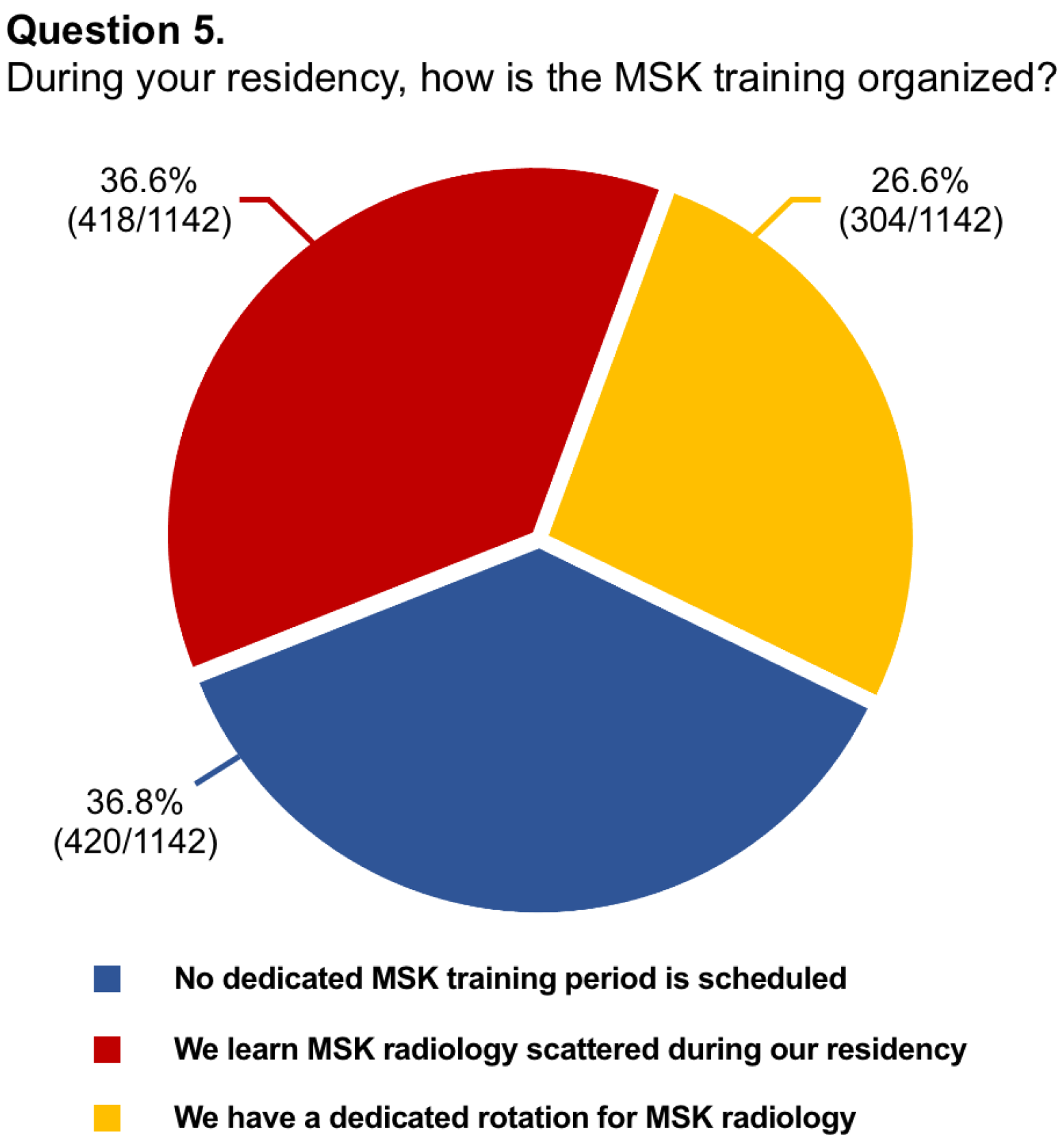
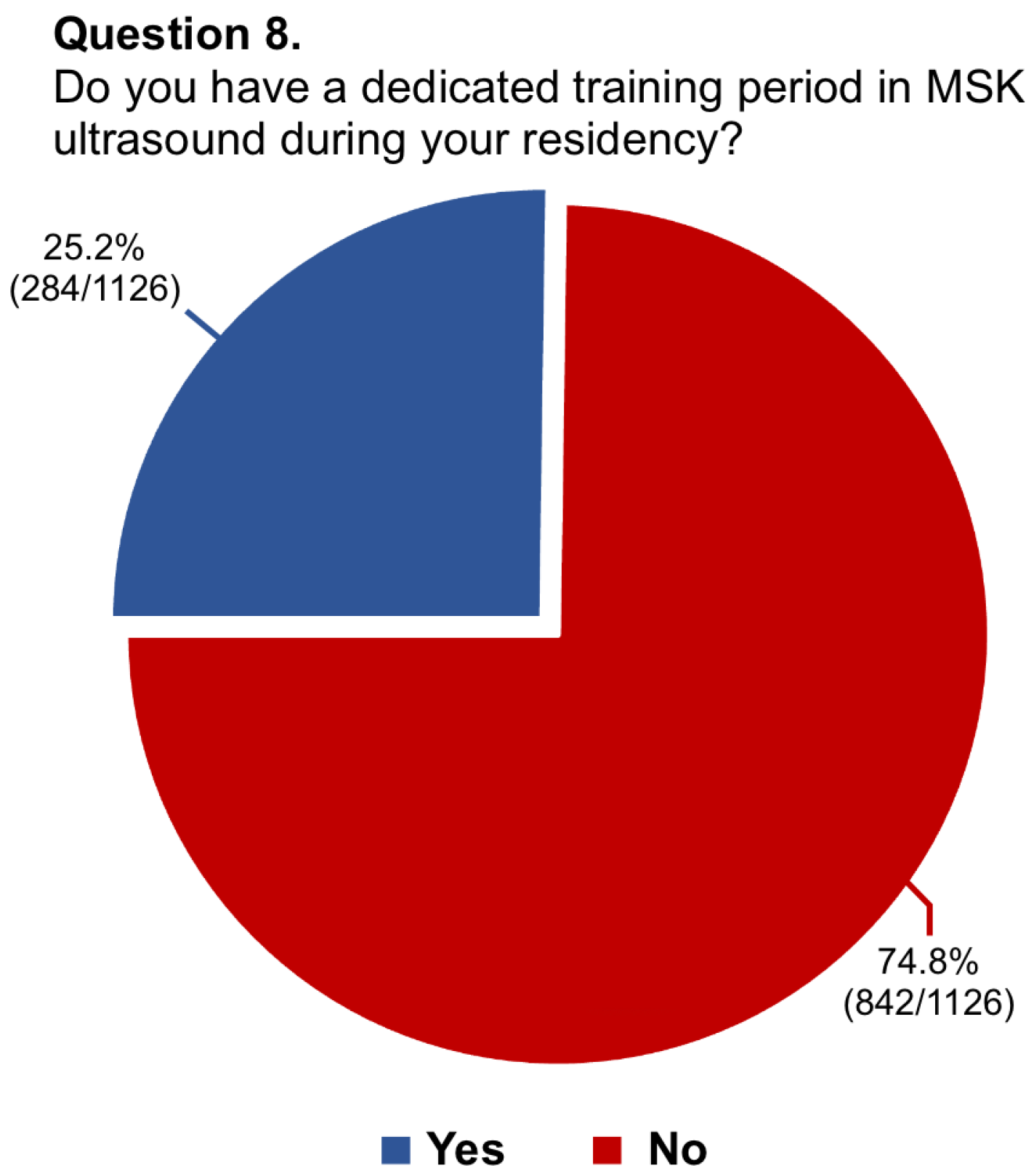
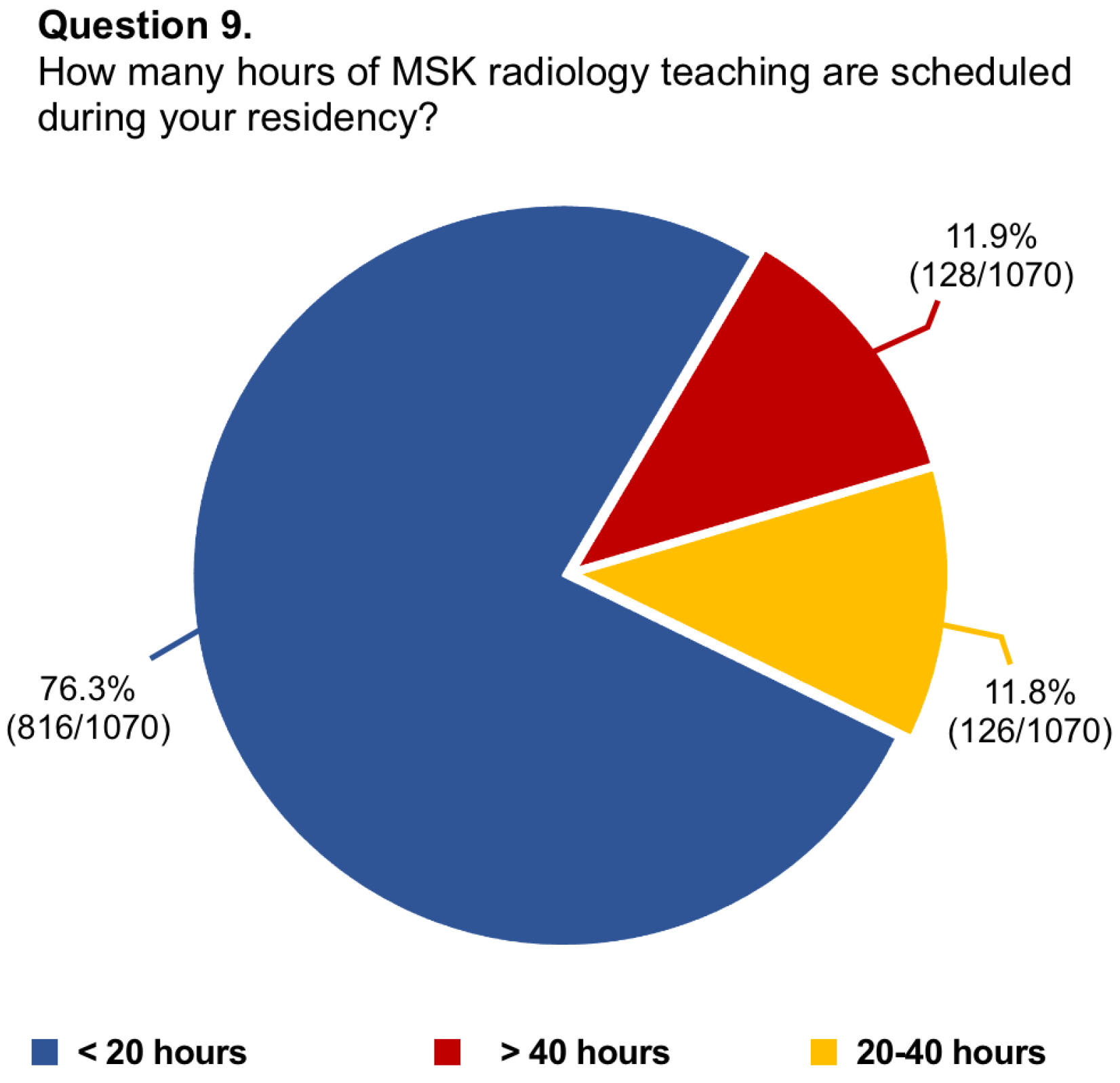
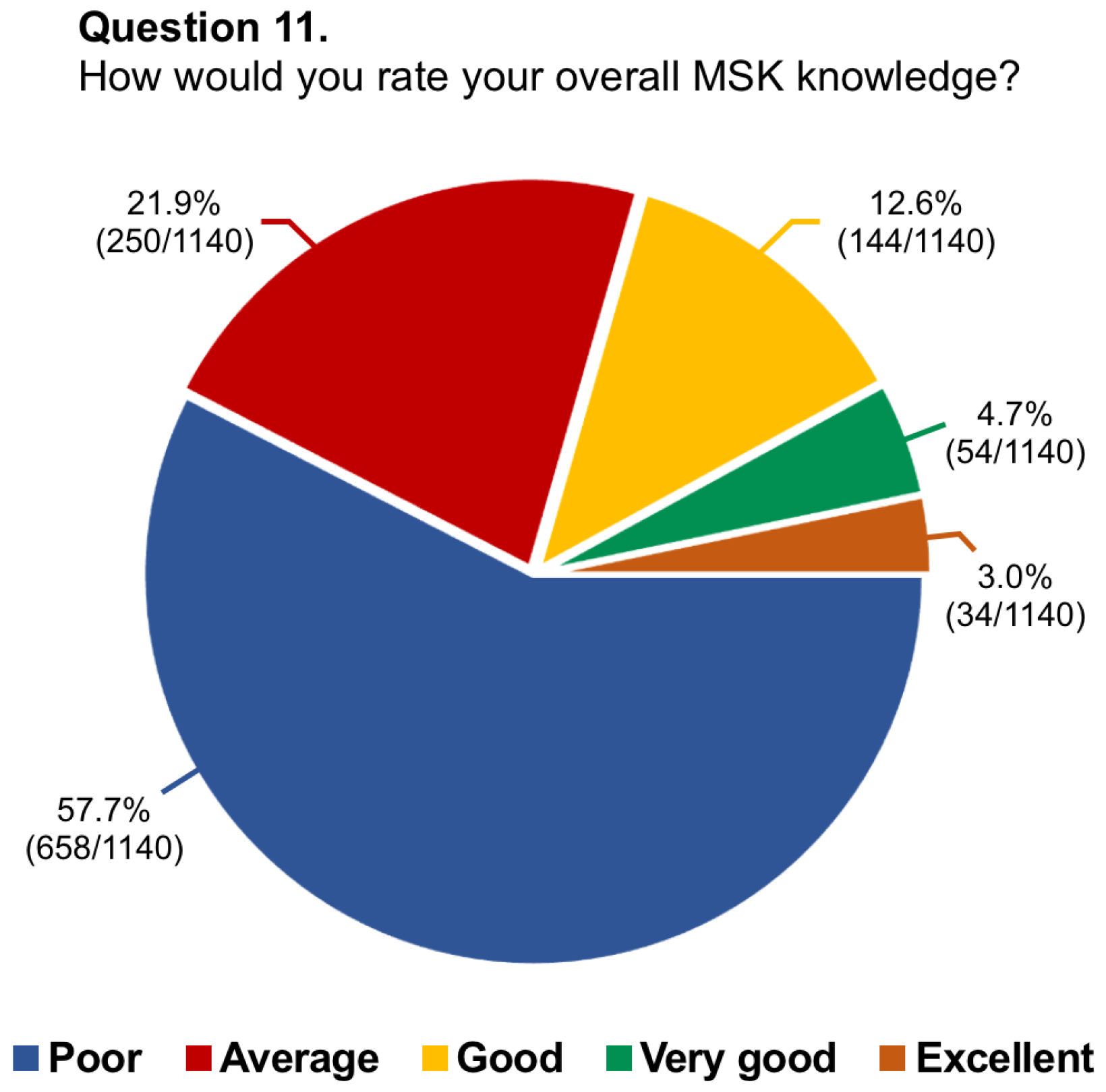

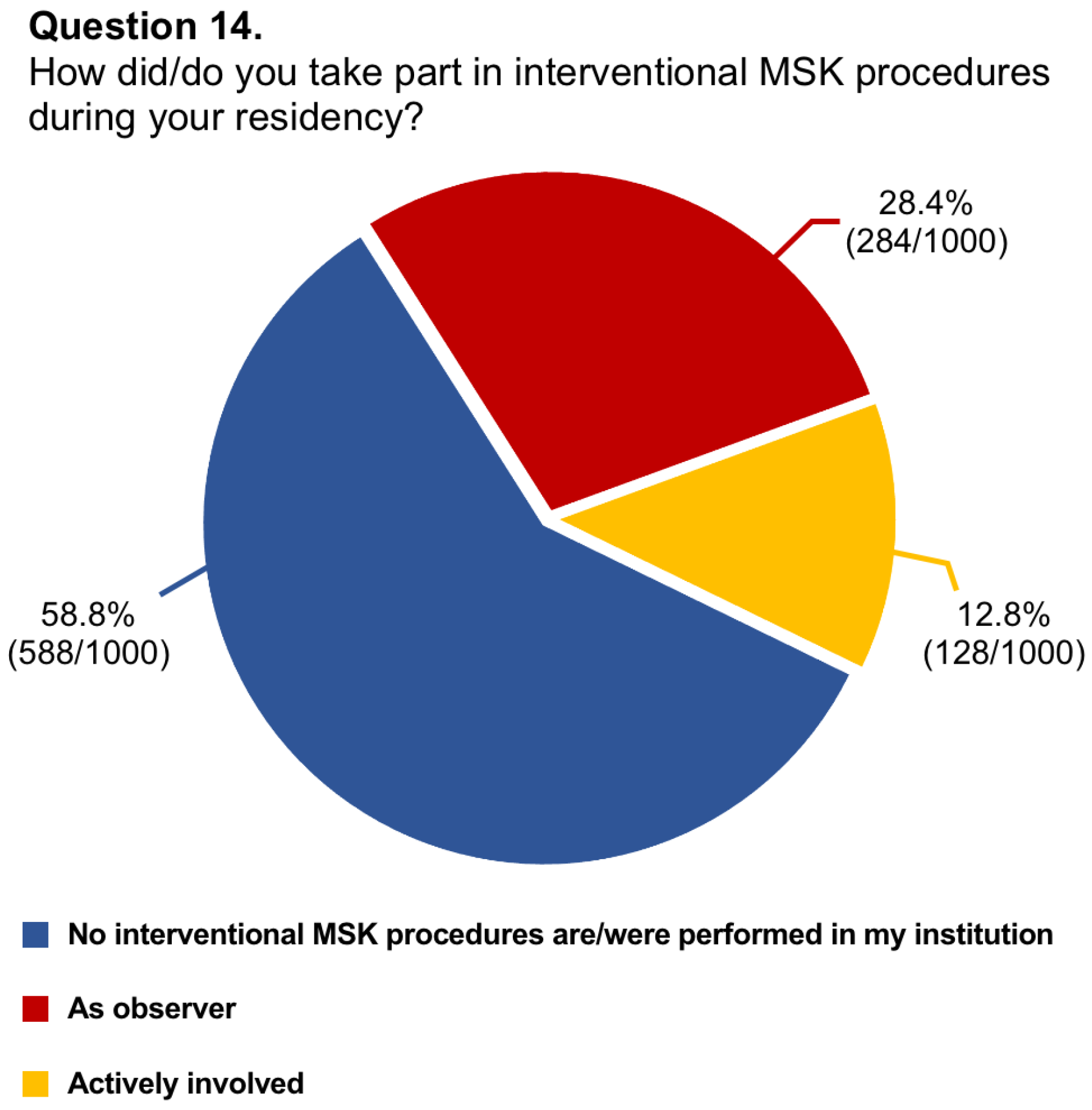
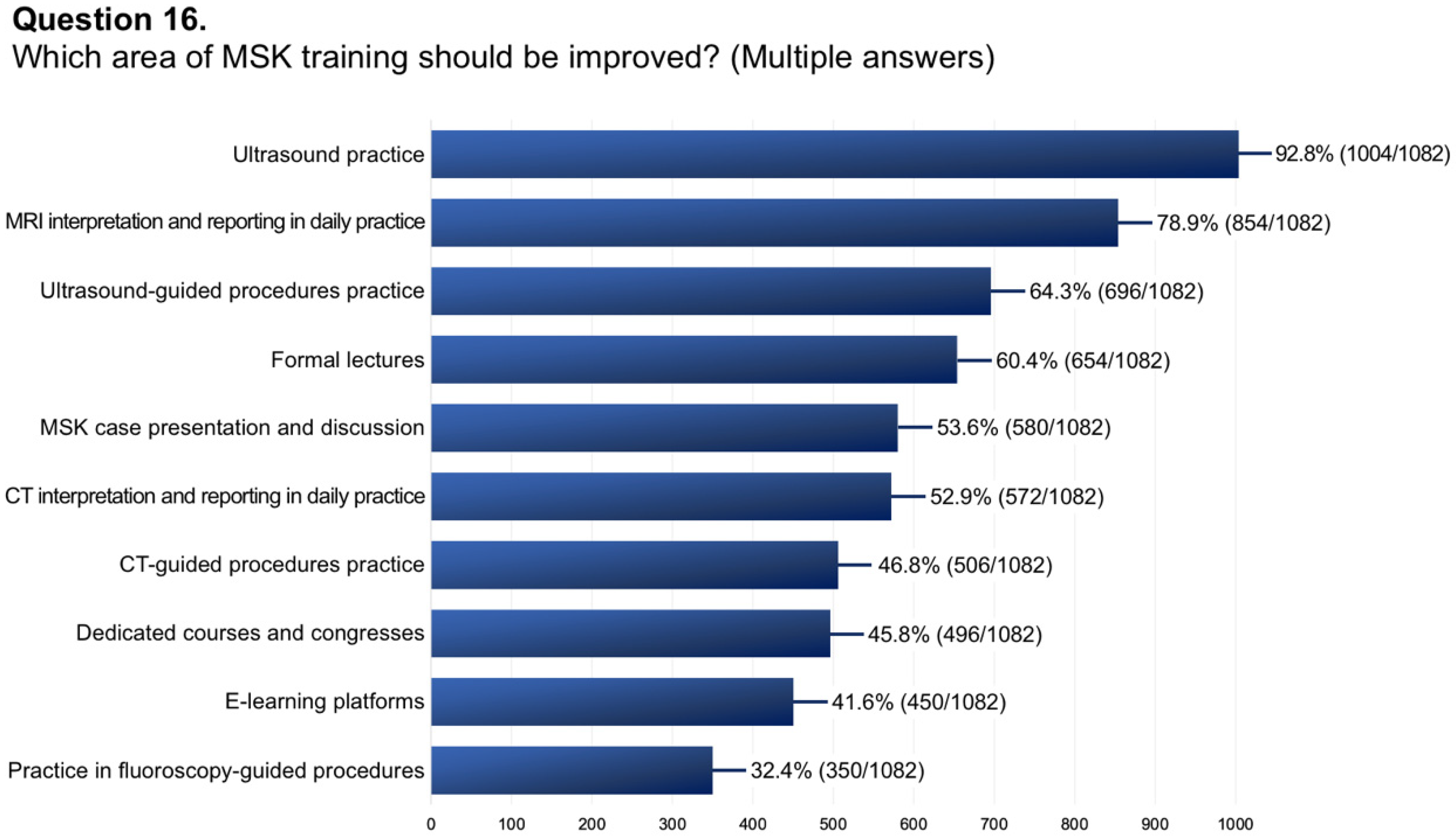
| Question | Total Answers | Answer |
|---|---|---|
| 1144/1144 (100%) | Mean: 31.4 ± 4 |
| (Range: 24–34) | ||
| 1140/1144 (99.7%) | See Table 2 |
| 1144/1144 (100%) | Resident: 740/1144 (64.7%) |
| Board-certified radiologist: 404/1144 (35.3%) | ||
| 1142/1144 (99.8%) | University hospital: 760/1142 (66.6%) |
| Public hospital: 304/1142 (26.6%) | ||
| Private clinic: 78/1142 (6.8%) | ||
| 1142/1144 (99.8%) | No dedicated MSK training period is scheduled in our programme: 420/1142 (36.8%) |
| We learn MSK radiology scattered during our residency: 418/1142 (36.6%) | ||
| We have a dedicated rotation for different subspecialties, included MSK radiology: 304/1142 (26.6%) | ||
| 300/304 (98.7%) | Between 3 and 6 months: 160/300 (53.3%) |
| Less than 3 months: 96/300 (32.0%) | ||
| Between 6 month and year: 28/300 (9.3%) | ||
| More than 1 year: 16/300 (5.3%) | ||
| 666/1144 (58.2%) | Residents rotate among the different imaging modalities: 424/666 (63.7%) |
| Residents are assigned to a specific imaging modality (e.g., MRI, ultrasound): 242/666 (36.3%) | ||
| 1126/1144 (98.4%) | No: 842/1126 (74.8%) |
| Yes: 284/1126 (25.2%) | ||
| 1070/1144 (93.5%) | <20 h: 816/1070 (76.3%) |
| >40 h: 128/1070 (11.9%) | ||
| 20–40 h: 126/1070 (11.8%) | ||
| 1020/1144 (89.2%) | Senior consultants: 456/1020 (44.7%) |
| Other residents: 208/1020 (20.4%) | ||
| Junior specialists: 204/1020 (20.0%) | ||
| University Professor: 152/1020 (14.9%) | ||
| 1140/1144 (99.7%) | Poor: 658/1140 (57.7%) |
| Average: 250/1140 (21.9%) | ||
| Good: 144/1140 (12.6%) | ||
| Very good: 54/1140 (4.7%) | ||
| Excellent: 34/1140 (3.0%) | ||
| 1140/1144 (99.7%) | Daily clinical practice (under supervision): 1052/1140 (92.3%) |
| Dedicated courses and congresses: 544/1140 (47.7%) | ||
| E-learning platforms: 446/1140 (39.1%) | ||
| Clinical case-based presentations: 386/1140 (33.9%) | ||
| 1120/1144 (97.9%) | No: 950/1120 (84.8%) |
| Yes: 170/1120 (15.2%) | ||
| 1000/1144 (87.4%) | No interventional MSK procedures are/were performed in my institution: 588/1000 (58.8%) |
| As observer: 284/1000 (28.4%) | ||
| Actively involved: 128/1000 (12.8%) | ||
| 1132/1144 (98.9%) | Yes: 1062/1132 (93.8%) |
| No: 70/1132 (6.2%) | ||
| 1082/1144 (94.6%) | Ultrasound practice: 1004/1082 (92.8%) |
| MRI interpretation and reporting during daily clinical practice: 854/1082 (78.9%) | ||
| Ultrasound-guided procedures practice: 696/1082 (64.3%) | ||
| Formal lectures: 654/1082 (60.4%) | ||
| MSK case presentation and discussion: 580/1082 (53.6%) | ||
| CT interpretation and reporting during daily clinical practice: 572/1082 (52.9%) | ||
| CT-guided procedures practice: 506/1082 (46.8%) | ||
| Dedicated courses and congresses: 496/1082 (45.8%) | ||
| E-learning platforms: 450/1082 (41.6%) | ||
| Practice in fluoroscopy-guided procedures: 350/1082 (32.4%) | ||
| 1138/1144 (99.5%) | Yes: 776/1138 (78.2%) |
| I am not sure: 214/1138 (18.8%) | ||
| No: 148/1138 (13.0%) |
| Region of the Residency Programme | Total Answers |
|---|---|
| Lombardia * | 162 |
| Sicilia ‡ | 160 |
| Lazio § | 112 |
| Toscana § | 112 |
| Veneto * | 108 |
| Piemonte * | 84 |
| Emilia Romagna * | 72 |
| Campania ‡ | 58 |
| Abruzzo ‡ | 56 |
| Molise ‡ | 50 |
| Umbria § | 46 |
| Puglia ‡ | 42 |
| Friuli Venezia Giulia * | 30 |
| Liguria * | 16 |
| Sardegna ‡ | 14 |
| Calabria ‡ | 10 |
| Marche § | 8 |
| Question | Answers | Lombardia | Sicilia | Lazio | Toscana | Veneto |
|---|---|---|---|---|---|---|
| 5. During your residency, how is the MSK training organized? | We have a dedicated rotation for different subspecialties, included MSK radiology | 130/162 (80.3%) | 18/158 (11.4%) | 20/112 (17.9%) | 40/112 (35.7%) | 6/108 (5.5%) |
| We learn MSK radiology scattered during our residency | 28/162 (17.3%) | 32/158 (20.3%) | 50/112 (44.6%) | 38/112 (33.9%) | 52/108 (48.2%) | |
| No dedicated MSK training period is scheduled in our programme | 4/162 (2.5%) | 108/158 (68.3%) | 42/112 (37.5%) | 34/112 (30.4) | 50/108 (46.3%) | |
| 6. If a dedicated rotation in MSK radiology is scheduled, how long does it last? | Between 3 and 6 months | 48/130 (36.9%) | 12/18 (66.7%) | 14/20 (70.0%) | 8/40 (20.0%) | 2/6 (33.3%) |
| Less than 3 months | 88/130 (67.7%) | 4/18 (22.2%) | 6/20 (30.0%) | 32/40 (80.0%) | 2/6 (33.3%) | |
| Between 6 month and year | 12/130 (9.2%) | 2/18 (11.1%) | 0/20 (0.0%) | 0/40 (0.0%) | 0/6 (0.0%) | |
| More than 1 year | 2/130 (1.5%) | 0/18 (0.0%) | 0/20 (0.0%) | 0/40 (0.0%) | 2/6 (33.3%) | |
| 8. Do you have a dedicated training period in MSK ultrasound during your residency? | No | 80/160 (50%) | 120/156 (76.9%) | 96/110 (87.3%) | 90/110 (81.8%) | 104/108 (96.3%) |
| Yes | 80/160 (50%) | 36/156 (23.1%) | 14/110 (12.7%) | 20/110 (18.2%) | 4/108 (3.7%) | |
| 9. How many hours of MSK radiology teaching are scheduled during your residency? | <20 h | 102/160 (63.8%) | 124/140 (88.6%) | 84/104 (80.8%) | 82/98 (83.7%) | 96/104 (92.3%) |
| 20–40 h | 24/160 (15.0%) | 10/140 (7.1%) | 10/104 (9.6%) | 10/98 (10.2%) | 4/104 (3.9%) | |
| >40 h | 34/160 (21.2%) | 6/140 (4.3%) | 10/104 (9.6%) | 6/98 (6.1%) | 4/104 (3.9%) | |
| 11. How would you rate your overall MSK knowledge? | Poor | 54/162 (33.3%) | 106/158 (67.1%) | 58/112 (51.8%) | 86/112 (76.8%) | 80/108 (74.1%) |
| Average | 42/162 (25.9%) | 22/158 (13.9%) | 28/112 (25.0%) | 20/112 (17.9%) | 20/108 (18.5%) | |
| Good | 36/162 (22.2%) | 18/158 (11.4%) | 14/112 (12.5%) | 4/112 (3.6%) | 6/108 (5.6%) | |
| Very good | 20/162 (12.4%) | 8/158 (5.1%) | 10/112 (8.9%) | 2/112 (1.8%) | 0/108 (0.0%) | |
| Excellent | 10/162 (6.2%) | 4/158 (2.5%) | 2/112 (1.8%) | 0/112 (0.0%) | 2/108 (1.9%) | |
| 13. Do you have a dedicated training period in MSK interventional radiology during your residency? | No | 120/160 (75.0%) | 146/156 (93.6%) | 106/112 (94.6%) | 88/108 (81.5%) | 106/106 (100%) |
| Yes | 40/160 (25.0%) | 10/156 (6.4%) | 6/112 (5.4%) | 20/108 (18.5%) | 0/106 (0.0%) | |
| 14. How did/do you take part in interventional MSK procedures during your residency? | No interventional MSK procedures are/were performed in my institution | 54/152 (35.5%) | 84/130 (64.6%) | 80/94 (85.1%) | 40/96 (41.7%) | 84/94 (89.4%) |
| As observer | 68/152 (44.7%) | 40/130 (30.7%) | 10/94 (10.6%) | 38/96 (39.6%) | 10/94 (10.6%) | |
| Actively involved | 30/152 (19.7%) | 6/130 (4.6%) | 4/94 (4.3%) | 18/96 (18.8%) | 0/94 (0.0%) | |
| 15. Do you think that MSK training should be improved in your residency programme? | Yes | 128/158 (81.0%) | 156/158 (98.7%) | 110/112 (98.2%) | 106/110 (96.4%) | 108/108 (100%) |
| No | 30/158 (19.0%) | 2/158 (1.3%) | 2/112 (1.8%) | 4/110 (3.6%) | 0/108 (0.0%) |
| Question | Answers | Northern Italy, n = 472 (41.3%) | Central Italy, n = 278 (24.3%) | Southern Italy and Islands, n = 394 (34.4%) |
|---|---|---|---|---|
| 5. During your residency, how is the MSK training organized? | We have a dedicated rotation for different subspecialties, included MSK radiology | 198/472 (42.0%) | 60/278 (21.6%) | 46/392 (11.7%) |
| We learn MSK radiology scattered during our residency | 164/472 (34.7%) | 102/278 (36.7%) | 152/392 (38.8%) | |
| No dedicated MSK training period is scheduled in our programme | 110/472 (23.3%) | 116/278 (41.7%) | 194/392 (49.5%) | |
| 6. If a dedicated rotation in MSK radiology is scheduled, how long does it last? | Between 3 and 6 months | 62/196 (31.6%) | 22/60 (36.7%) | 12/44 (27.3%) |
| Less than 3 months | 112/196 (57.1%) | 38/60 (63.3%) | 10/44 (22.7%) | |
| Between 6 month and year | 16/196 (8.2%) | 0/0 (0.0%) | 12/44 (27.3%) | |
| More than 1 year | 6/196 (3.1%) | 0/0 (0.0%) | 10/44 (22.7%) | |
| 8. Do you have a dedicated training period in MSK ultrasound during your residency? | No | 316/464 (68.1%) | 234/272 (86.0%) | 292/390 (74.9%) |
| Yes | 148/464 (31.9%) | 38/272 (14.0%) | 98/390 (25.1%) | |
| 9. How many hours of MSK radiology teaching are scheduled during your residency? | <20 h | 340/452 (75.2%) | 212/250 (84.8%) | 264/368 (71.7%) |
| 20–40 h | 56/452 (12.4%) | 22/250 (8.8%) | 48/368 (13.1%) | |
| >40 h | 56/452 (12.4%) | 16/250 (6.4%) | 56/368 (15.2%) | |
| 11. How would you rate your overall MSK knowledge? | Poor | 250/470 (53.2%) | 186/278 (66.9%) | 222/392 (56.6%) |
| Average | 110/470 (23.4%) | 56/278 (20.1%) | 84/392 (21.4%) | |
| Good | 70/470 (14.9%) | 22/278 (7.9%) | 52/392 (13.3%) | |
| Very good | 24/470 (5.1%) | 12/278 (4.3%) | 18/392 (4.6%) | |
| Excellent | 16/470 (3.4%) | 2/278 (0.7%) | 16/392 (4.1%) | |
| 13. Do you have a dedicated training period in MSK interventional radiology during your residency? | No | 386/460 (83.9%) | 246/272 (90.4%) | 318/388 (82.0%) |
| Yes | 74/460 (16.1%) | 26/272 (9.6%) | 70/388 (18.0%) | |
| 14. How did/do you take part in interventional MSK procedures during your residency? | No interventional MSK procedures are/were performed in my institution | 222/426 (52.1%) | 156/232 (67.2%) | 210/342 (61.4%) |
| As observer | 142/426 (33.3%) | 52/232 (22.4%) | 90/342 (26.3%) | |
| Actively involved | 62/426 (14.6%) | 24/232 (10.3%) | 42/342 (12.3%) | |
| 15. Do you believe that MSK training should be improved in your residency programme? | Yes | 434/468 (92.7%) | 268/274 (97.8%) | 360/390 (92.3%) |
| No | 34/468 (7.3%) | 6/274 (2.2%) | 30/390 (7.7%) |
Disclaimer/Publisher’s Note: The statements, opinions and data contained in all publications are solely those of the individual author(s) and contributor(s) and not of MDPI and/or the editor(s). MDPI and/or the editor(s) disclaim responsibility for any injury to people or property resulting from any ideas, methods, instructions or products referred to in the content. |
© 2023 by the authors. Licensee MDPI, Basel, Switzerland. This article is an open access article distributed under the terms and conditions of the Creative Commons Attribution (CC BY) license (https://creativecommons.org/licenses/by/4.0/).
Share and Cite
Albano, D.; Fusco, S.; Zappia, M.; Sconfienza, L.M.; Giovagnoni, A.; Aliprandi, A.; Messina, C. Musculoskeletal Radiology Education: A National Survey by the Italian College of Musculoskeletal Radiology. Diagnostics 2024, 14, 40. https://doi.org/10.3390/diagnostics14010040
Albano D, Fusco S, Zappia M, Sconfienza LM, Giovagnoni A, Aliprandi A, Messina C. Musculoskeletal Radiology Education: A National Survey by the Italian College of Musculoskeletal Radiology. Diagnostics. 2024; 14(1):40. https://doi.org/10.3390/diagnostics14010040
Chicago/Turabian StyleAlbano, Domenico, Stefano Fusco, Marcello Zappia, Luca Maria Sconfienza, Andrea Giovagnoni, Alberto Aliprandi, and Carmelo Messina. 2024. "Musculoskeletal Radiology Education: A National Survey by the Italian College of Musculoskeletal Radiology" Diagnostics 14, no. 1: 40. https://doi.org/10.3390/diagnostics14010040
APA StyleAlbano, D., Fusco, S., Zappia, M., Sconfienza, L. M., Giovagnoni, A., Aliprandi, A., & Messina, C. (2024). Musculoskeletal Radiology Education: A National Survey by the Italian College of Musculoskeletal Radiology. Diagnostics, 14(1), 40. https://doi.org/10.3390/diagnostics14010040







